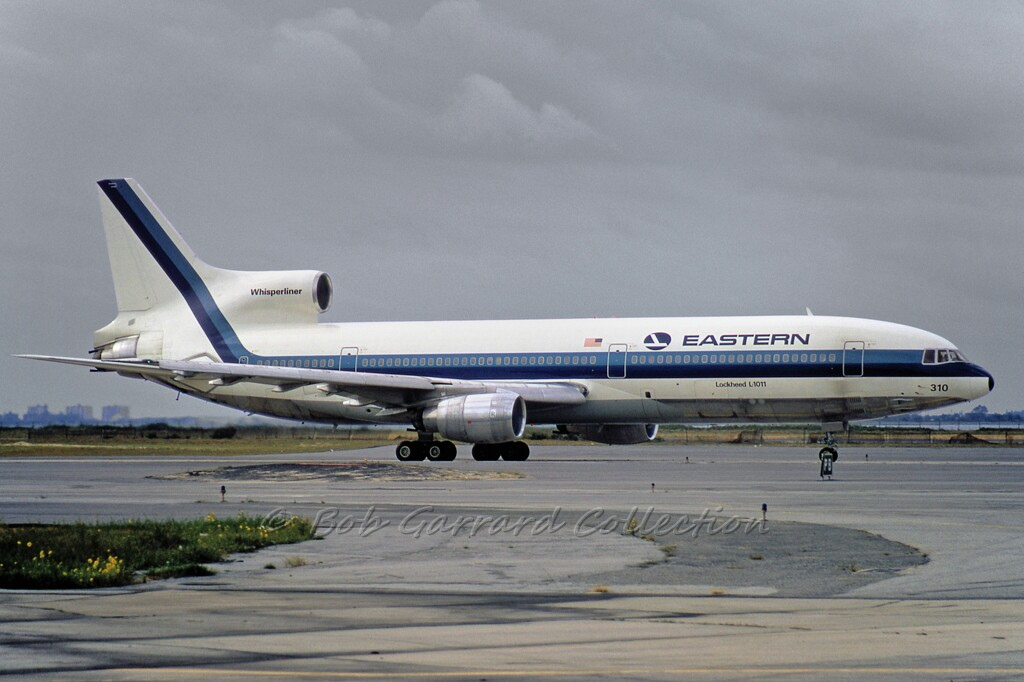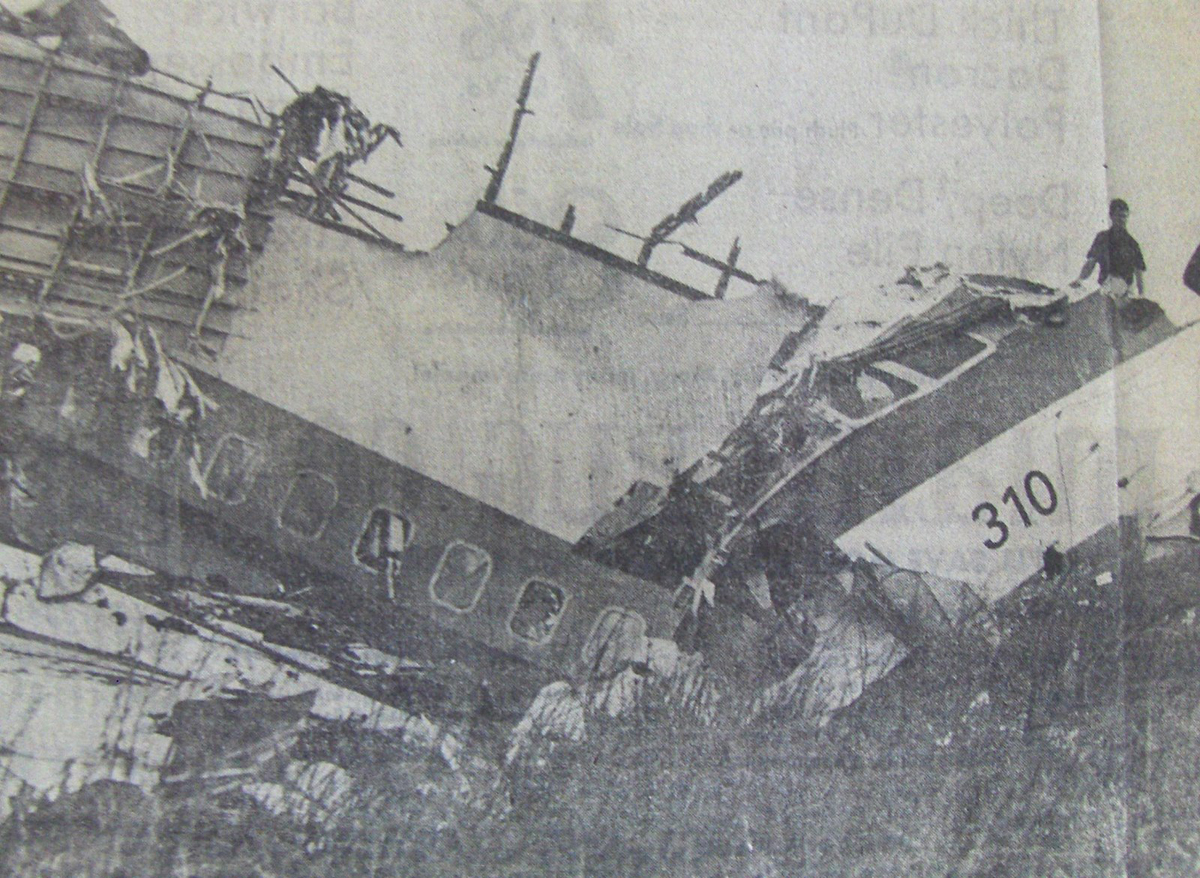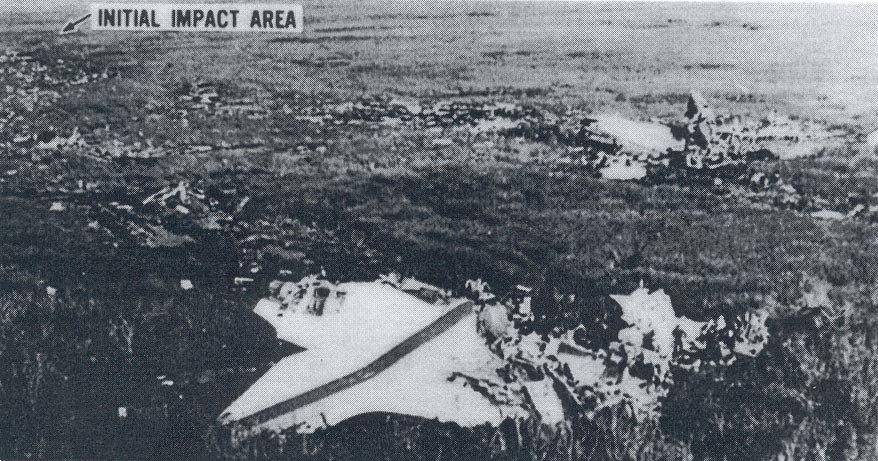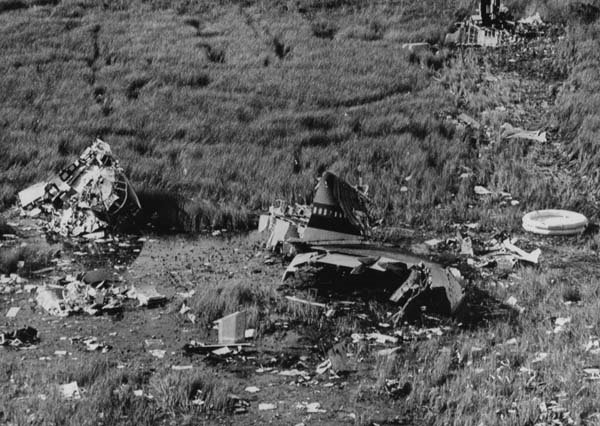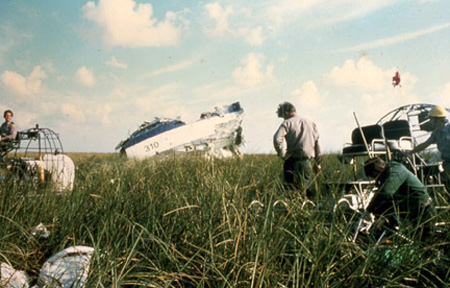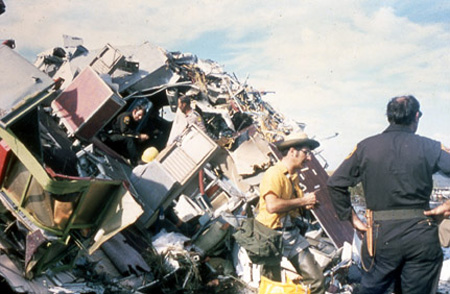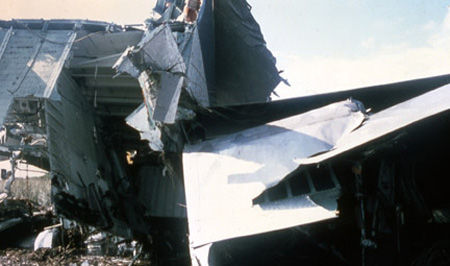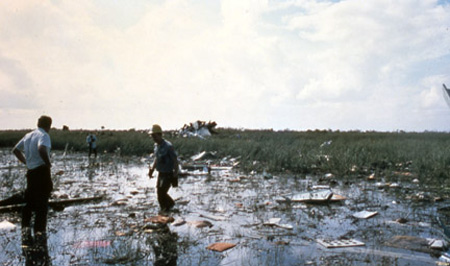Country
Operator Image

Crash of a Douglas DC-9-31 in Pensacola
Date & Time:
Dec 28, 1987 at 2339 LT
Registration:
N8948E
Survivors:
Yes
Schedule:
Richmond – Atlanta – Pensacola
MSN:
47184/274
YOM:
1968
Flight number:
EA573
Crew on board:
4
Crew fatalities:
Pax on board:
103
Pax fatalities:
Other fatalities:
Total fatalities:
0
Captain / Total hours on type:
4397.00
Aircraft flight hours:
55645
Circumstances:
Eastern flight 573 contacted approach control at 2323 cst, was advised to expect an ILS runway 16 approach and was vectored around weather. At 2330, the controller advised the ILS glide slope (g/s) had gone into 'alarm' but the loc appeared normal. At 2333, the wind shifted to 310° at 7 knots. Since the bc approach to runway 34 was notamed as inop, the crew continued to runway 16, using 50° of flaps. At 2334, they told the controller, 'if you don't get the g/s up, we'll do a... loc approach.' They reported receiving the g/s, but were advised the g/s was still in alarm. The aircraft broke out of clouds in rain at 900 feet; light turbulence was encountered on final approach. At about 1 mile out, the f/o noted the aircraft was high and advised the captain. The captain pushed the nose over and reduced power, increasing speed and rate of descent. Requested altitude callouts were not made. F/O advised captain to flare, but flare was inadequate. The aircraft touched down hard and the fuselage failed between stations 813 and 756. Aircraft was stopped with the tail resting on the runway. Four passengers received minor injuries during evacuation. Weather study showed a moderate to strong (vip level 2 to 3) weather echo over the approach end of runway 16.
Probable cause:
The captain's failure to maintain a proper descent rate on final approach or to execute a missed approach, which caused the airplane to contact the runway with a sink rate exceeding the airplane's design limitations. Contributing to the cause of the accident was the failure of the captain and first officer to make required altitude callouts and to properly monitor the flight instruments during the approach.
Final Report:
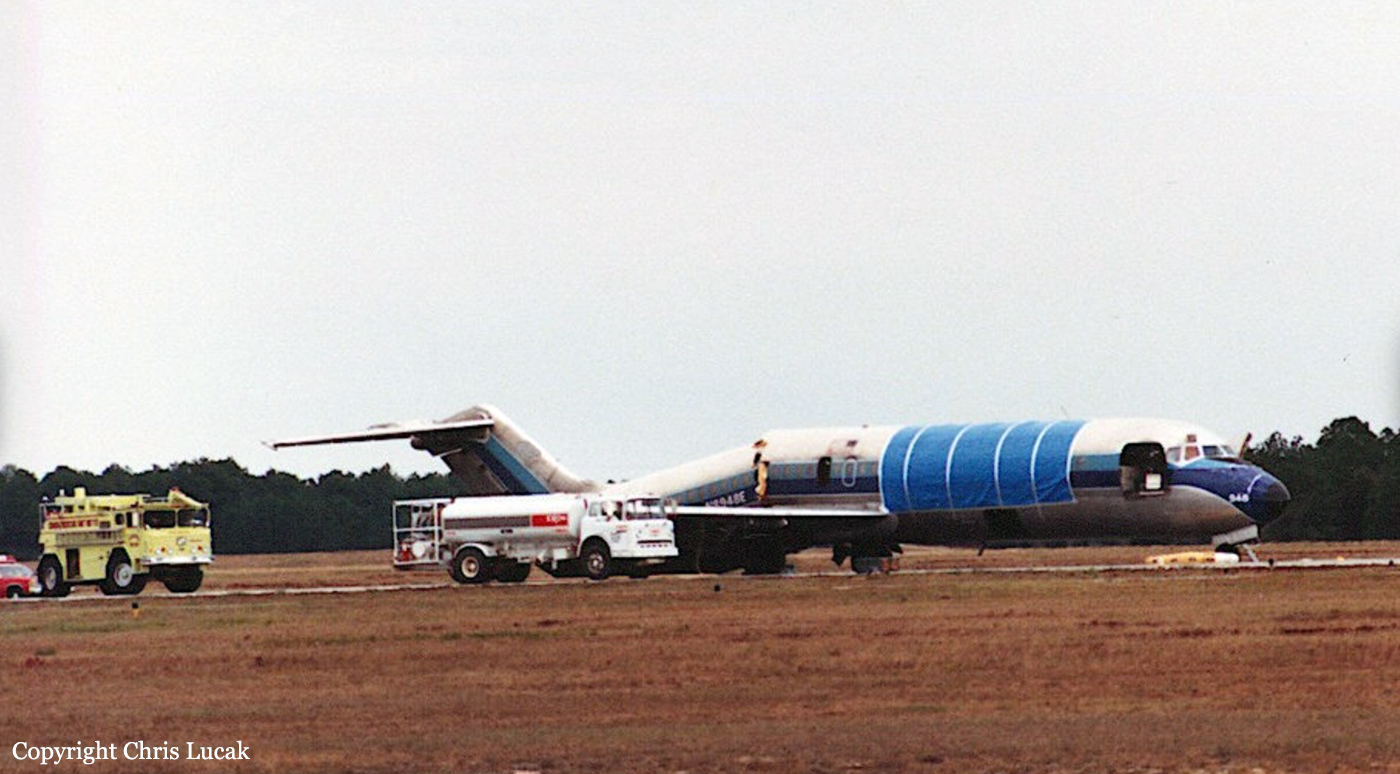

Crash of a Boeing 727-225 on Mt Nevado Illimani: 29 killed
Date & Time:
Jan 1, 1985 at 2030 LT
Registration:
N819EA
Survivors:
No
Schedule:
Asunción - La Paz
MSN:
22556
YOM:
1982
Flight number:
EA980
Crew on board:
10
Crew fatalities:
Pax on board:
19
Pax fatalities:
Other fatalities:
Total fatalities:
29
Circumstances:
After crossing Dakon intersection about 55 NM southeast of La Paz, the crew was cleared to descend from FL250 to FL180. The crew deviated from the prescribed route apparently to avoid bad weather when, at an altitude of 19,600 feet, the aircraft struck the slope of Mt Nevado Illimani (6,400 meters high) located 43 km southeast from runway 28. The aircraft disintegrated on impact and all 29 occupants were killed.
Probable cause:
Controlled flight into terrain after the crew failed to realize his altitude and path were incorrect while cruising in limited visibility due to the night and clouds up to 9,000 meters.
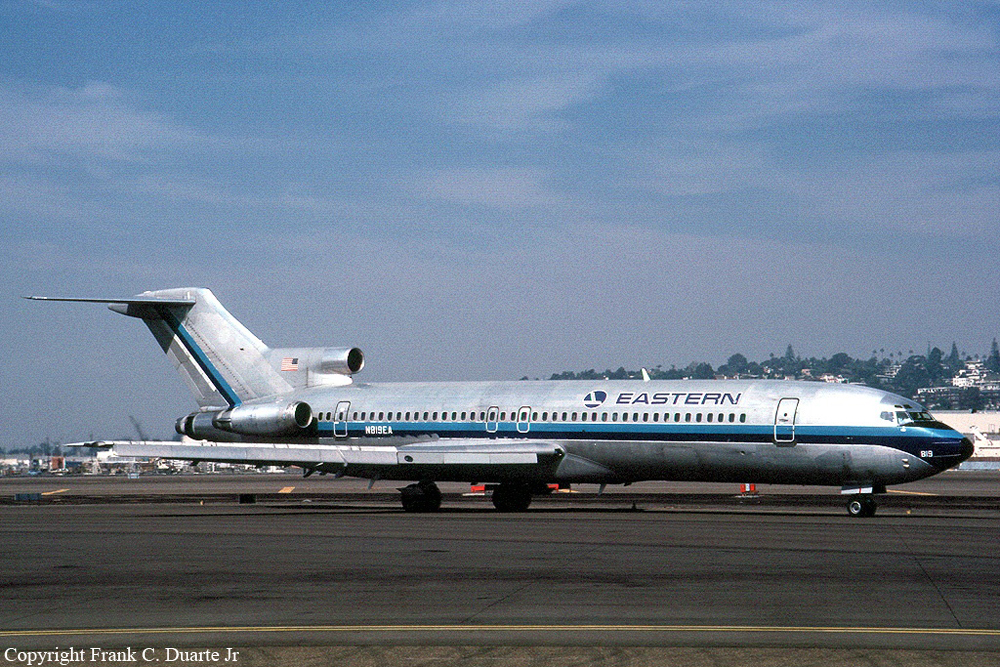

Crash of a Douglas DC-9-14 in Dade-Collier
Date & Time:
Feb 9, 1979 at 1712 LT
Registration:
N8910E
Survivors:
Yes
Schedule:
Dade-Collier - Dade-Collier
MSN:
45771/58
YOM:
1966
Crew on board:
4
Crew fatalities:
Pax on board:
1
Pax fatalities:
Other fatalities:
Total fatalities:
0
Captain / Total hours on type:
1959.00
Circumstances:
The airplane was dispatched at Dade-Collier Airport for a local training flight, carrying one instructor and four pilots under supervision. During the takeoff roll on runway 09/27, the pilot-in-command started the rotation when the instructor shut down the left engine to simulate an engine failure. The airplane rolled to the left, causing the left wing to struck the ground then nosed down and struck the runway surface. The nose gear was torn off and the aircraft nose and cockpit section was almost destroyed. All five occupants were injured, two of them seriously.
Probable cause:
Loss of control during initial climb due to improper operation of flight controls. The following contributing factors were reported:
- lack of familiarity with aircraft,
- Inadequate supervision of flight,
- Simulated conditions,
- First officer trainee upgrade training flight,
- Check captain adm simulated left engine failure at liftoff.
- lack of familiarity with aircraft,
- Inadequate supervision of flight,
- Simulated conditions,
- First officer trainee upgrade training flight,
- Check captain adm simulated left engine failure at liftoff.
Final Report:

Crash of a Boeing 727-225 in New York: 113 killed
Date & Time:
Jun 24, 1975 at 1605 LT
Registration:
N8845E
Survivors:
Yes
Schedule:
New Orleans - New York
MSN:
20443/837
YOM:
1970
Flight number:
EA066
Crew on board:
8
Crew fatalities:
Pax on board:
116
Pax fatalities:
Other fatalities:
Total fatalities:
113
Captain / Total hours on type:
2813.00
Copilot / Total hours on type:
4327
Aircraft flight hours:
12206
Circumstances:
Eastern Air Lines Flight 66, a Boeing 727-225 operated as a scheduled passenger flight from New Orleans to New York-JFK. The flight departed New Orleans about 13:19. It proceeded on an IFR flight plan. Eastern 66 arrived in the New York City terminal area without reported difficulty, and, beginning at 15:35:11, Kennedy approach control provided radar vectors to sequence the flight with other traffic and to position it for an ILS approach to runway 22L at the Kennedy airport. The automatic terminal information service (ATIS) reported: "Kennedy weather, VFR, sky partially obscured, estimated ceiling 4,000 broken, 5 miles with haze... wind 210° at 10, altimeter 30.15, Expect vectors to an ILS runway 22L, landing runway 22L, departures are off 22R... " At 15:52:43, the controller transmitted, "All aircraft this frequency, we just went IFR with 2 miles very light rain showers and haze. The runway visual range is---not available, and Eastern 66 descend and maintain four thousand, Kennedy radar one three two four." Eastern 66 acknowledged the transmission. At 15:53:22, the flight contacted the Kennedy final vector controller, who continued to provide radar vectors around thunderstorms in the area, to sequence the flight with other traffic, and to position the flight on the localizer course. The flight crew then discussed the problems associated with carrying minimum fuel loads when confronted with delays in terminal areas. One of the crewmembers stated that he was going to check the weather at the alternate airport, which was LaGuardia Airport (LGA). Less than a minute later, one of the crewmembers remarked, "... one more hour and we'd come down whether we wanted to or not." At 15:59:19, the final vector controller transmitted a message to all aircraft on his frequency that "a severe wind shift" had been reported on the final approach and that he would report more information shortly. Eastern Air Lines Flight 902, a Lockheed L-1011 TriStar, had abandoned its approach to runway 22L earlier. At 15:59:40, Eastern 902 re-established radio communications with the Kennedy final vector controller, and the flight crew reported, "... we had... a pretty good shear pulling us to the right and... down and visibility was nil, nil out over the marker... correction... at 200 feet it was... nothing." The final vector controller responded, "Okay, the shear you say pulled you right and down?" Eastern 902 replied, "Yeah, we were on course and down to about 250 feet. The airspeed dropped to about 10 knots below the bug and our rate of descent was up to 1,500 feet a minute, so we put takeoff power on and we went around at a hundred feet." While Eastern 902 was making this report, the captain of Eastern 66, said, "You know this is asinine." An unidentified crewmember responded, "I wonder if they're covering for themselves." The final vector controller asked Eastern 66 if they had heard Eastern 902's report. Eastern 66 replied, "...affirmative." The controller then established the flight's position as being 5 miles from the outer marker (OM) and cleared the flight for an ILS approach to runway 22L. Eastern 66 acknowledged the clearance at 16:00:54, "Okay, we'll let you know about the conditions." One minute later, the first officer, who was flying the aircraft, called for completion of the final checklist. While the final checklist items were being completed, the captain stated that the radar was, "Up and off... standby." At 16:02:20, the captain said, "...I have the radar on standby in case I need it, I can get it off later." At 16:02:42, the final vector controller asked Eastern 902, "..would you classify that as severe wind shift, correction, shear?" The flight responded, "Affirmative." The first officer of Eastern 66 then said, "Gonna keep a pretty healthy margin on this one. An unidentified crewmember said, "I...would suggest that you do" the first officer responded, "In case he's right." At 16:02:58, Eastern 66 reported over the OM, and the final vector controller cleared the flight to contact the Kennedy tower. The first officer requested 30° of flaps and the aircraft continued to bracket the glideslope with the airspeed oscillating between 140 and 145 knots. At 1603:12, the flight established communications with Kennedy tower local controller and reported that they were, "outer marker, inbound." The Kennedy tower local controller cleared Eastern 66 to land. The captain acknowledged the clearance and asked, "Got any reports on braking action...?" The local controller did not respond until the query was repeated. The local controller replied, "No,none, approach end of runway is wet... but I'd say about the first half is wet--we've had no adverse reports." At 1603:57.7, the flight engineer called, "1000 feet" and at 1604:25, the sound of rain was recorded. The flight was nearly centered on the glideslope when the flight engineer called, "500 feet." The airspeed was oscillating between 140 and 148 knots and the sound of heavy rain could be heard as the aircraft descended below 500 feet. The windshield wipers were switched to high speed. At 16:04:40, the captain said, "Stay on the gauges." The first officer responded, "Oh, yes. I'm right with it." The flight engineer reported, "Three greens, 30 degrees, final checklist," and the captain responded, "Right." At 16:04:52, the captain said, "I have approach lights," and the first officer said, "Okay." The captain then again said, "Stay on the gauges," and the first officer replied, "I'm with it." N8845E then was passing through 400 feet, and its rate of descent increased from an average of about 675 fpm to 1,500 fpm. The aircraft rapidly began to deviate below the glideslope, and 4 seconds later, the airspeed decreased from 138 kts to 123 kts in 2.5 seconds. The Boeing 727 continued to deviate further below the glideslope, and at 16:05:06.2, when the aircraft was at 150 feet, the captain said, "runway in sight." Less than a second later, the first officer said, "I got it." The captain replied, "got it?" and a second later, at 16:05:10, an unintelligible exclamation was recorded, and the first officer commanded, "Takeoff thrust." The airplane contacted the top of the No. 7 approach light tower at an elevation of 27 feet above the mean low-water level and 2,400 feet from the threshold of runway 22L. The aircraft continued and struck towers 8 and 9. The aircraft’s left wing was damaged severely by impact with these towers--the outboard section was severed. The aircraft then rolled into a steep left bank, well in excess of 90°. It contacted the ground and the fuselage struck five other towers. The aircraft then continued to Rockaway Boulevard, where it came to rest. The approach light towers and large boulders along the latter portion of the path caused the fuselage to collapse and disintegrate. A fire had erupted after the left wing failed.
Probable cause:
The aircraft's encounter with adverse winds associated with a very strong thunderstorm located astride the ILS localizer course, which resulted in high descent rate into the non-frangible approach light towers. The flight crew's delayed recognition and correction of the high descent rate were probably associated with their reliance upon visual cues rather than on flight instrument reference. However, the adverse winds might have been too severe for a successful approach and landing even had they relied upon and responded rapidly to the indications of the flight instruments. Contributing to the accident was the continued use of runway 22L when it should have become evident to both air traffic control personnel and the flight crew that a severe weather hazard existed along the approach path.
Final Report:
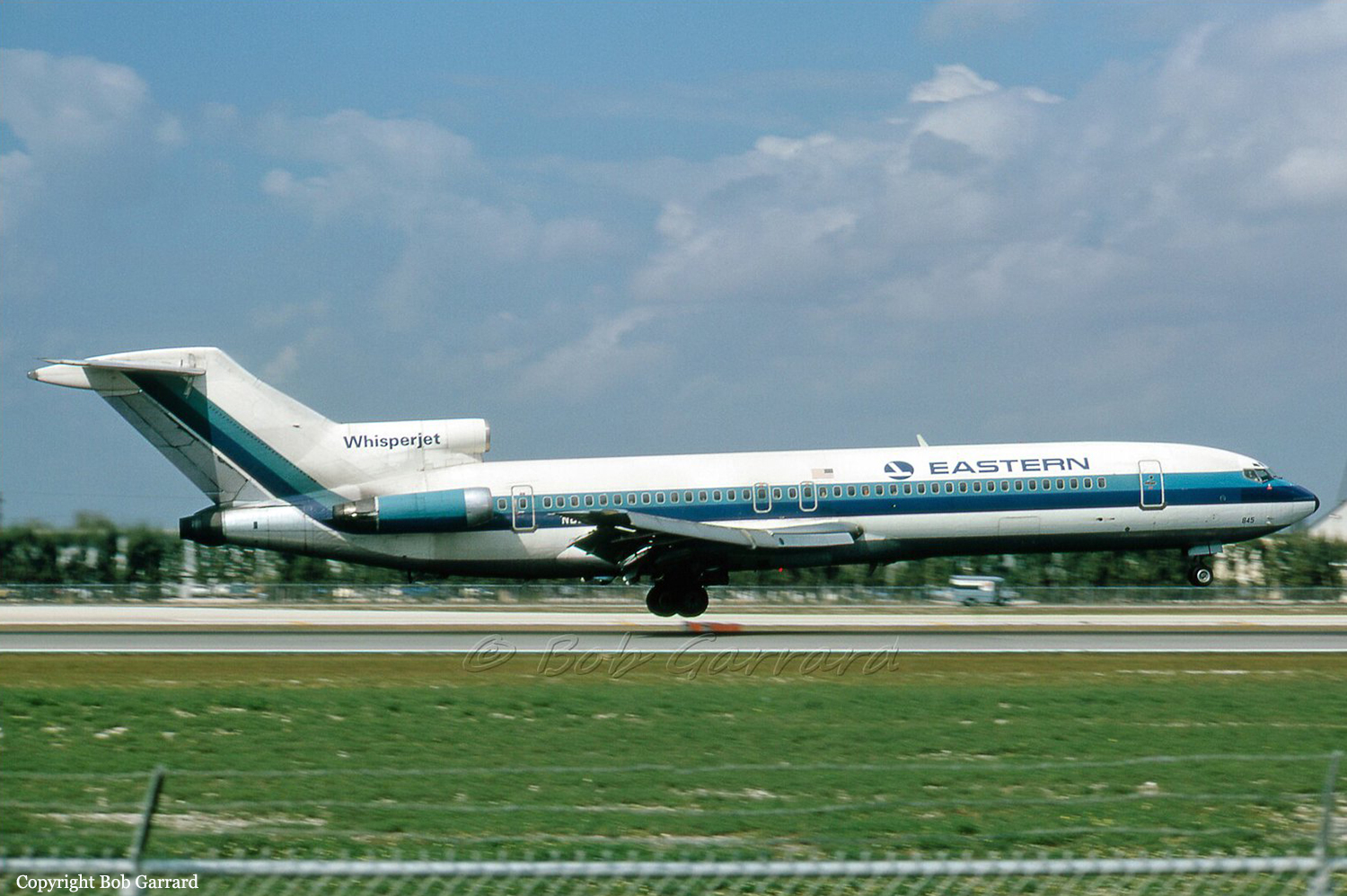


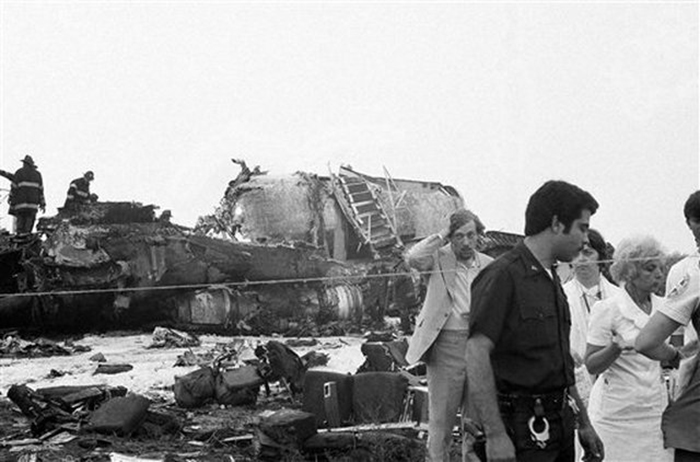
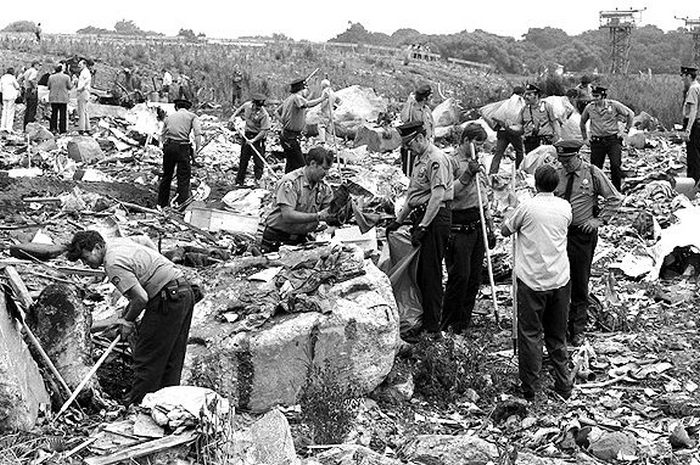







Crash of a Douglas DC-9-31 in Charlotte: 72 killed
Date & Time:
Sep 11, 1974 at 0734 LT
Registration:
N8984E
Survivors:
Yes
Schedule:
Charleston - Charlotte - Chicago
MSN:
47400/443
YOM:
1969
Flight number:
EA212
Crew on board:
4
Crew fatalities:
Pax on board:
78
Pax fatalities:
Other fatalities:
Total fatalities:
72
Captain / Total hours on type:
3856.00
Copilot / Total hours on type:
2693
Aircraft flight hours:
16860
Circumstances:
Eastern Air Lines Flight 212, a Douglas DC-9-31, N8984E, operated as a scheduled passenger flight from Charleston, South Carolina, to Chicago, Illinois, with an en route stop at Charlotte, North Carolina. The flight departed Charleston at 07:00 hours local time with 78 passengers and 4 crew members on board. The first officer was Pilot Flying. During the descent into Charlotte, until about 2 minutes and 30 seconds prior to the accident, the flight crew engaged in conversations not pertinent to the operation of the aircraft. These conversations covered a number of subjects, from politics to used cars, and both crew members expressed strong views and mild aggravation concerning the subjects discussed. At 07:32:13, as the flight intercepted the inbound VOR radial for the approach, the flight crew commenced a discussion of Carowinds Tower, which was located ahead and to the left of the projected flight path. This discussion lasted 35 seconds, during which 12 remarks were made concerning the subject. A considerable degree of the flight crew's attention was directed outside the cockpit during that time. During this period, the aircraft descended through 1,800 feet (1,074 feet above touchdown elevation), the altitude which should have been maintained until it crossed Ross Intersection, the final approach fix (FAF). At the end of the 35-second period, the aircraft was still 1.5 nm short of the FAF. At 07:32:41, during the latter part of the discussion regarding Carowinds Tower, the terrain warning alert sounded in the cockpit, signifying that the aircraft was 1,000 feet above the ground. Within seconds after the discussion of Carowinds Tower terminated at 07:32:48, the rate of descent of the aircraft was slowed from about 1,500 feet per minute to less than 300 feet per minute. At 07:33:24, the aircraft passed over Ross Intersection (the FAF) at an altitude of 1,350 feet (624 feet above field elevation), which is 450 feet below the prescribed crossing altitude. The captain did not make the required callout at the FAF, which should have included the altitude (above field elevation) and deviation from the Vref speed. Although shortly before crossing the FAF, one of the pilots stated "three ninety four," a reference to the MDA in height above field elevation. While in the vicinity of Ross Intersection, the first officer asked for 50 degrees of flaps; this request was carried out by the captain. The airspeed at this time was 168 knots, as contrasted with the recommended procedure which calls for the airspeed when passing over the FAF to be in the area of Vref, which in this instance was 122 knots. At 07:33:36, the captain advised Charlotte Tower that they were by Ross Intersection. The local controller cleared the flight to land on runway 36. The last radio transmission from the flight was the acknowledgement, "Alright," at 07:33:46. Shortly after passing Ross Intersection, the aircraft passed through an altitude of 500 feet above field elevation, which should have prompted the captain to call out altitude, deviation from Vref speed, and rate of descent. No such callout was made, nor was the required callout made when the plane descended through an altitude 100 feet above the MDA of 394 feet above the field elevation. The descent rate, after passing Ross, increased to 800 feet per minute, where it stabilized until approximately 7 to 8 seconds prior to impact, when it steepened considerably. According to the CVR, at 0733:52, the captain said, "Yeah, we're all ready," followed shortly thereafter by "All we got to do is find the airport". At 07:33:57, the first officer answered "Yeah". About one-half second later both pilots shouted. The aircraft struck some small trees and then impacted a cornfield about 100 feet below the airport elevation of 748 feet. The aircraft struck larger trees, broke up, and burst into flames. It was destroyed by the impact and ensuing fire. The aircraft crashed about 1.75 statute miles from Ross Intersection and about 3.3 statute miles short of the threshold of runway 36. Eleven passengers and two crew members survived the crash and fire. One passenger died 3 days after the crash, one after 6 days and another passenger died 29 days after the accident.
Probable cause:
The flight crew's lack of altitude awareness at critical points during the approach due to poor cockpit discipline in that the crew did not follow prescribed procedure. The following factors were reported:
- The extraneous conversation conducted by the flight crew during the descent was symptomatic of a lax atmosphere in the cockpit which continued throughout the approach.
- The terrain warning alert sounded at 1,000 feet above the ground but was not heeded by the flight crew,
- The aircraft descended through the final approach fix altitude of 1,800 feet more than 2 miles before the final approach fix was reached at an airspeed of 186 knots,
- The aircraft passed over the final approach fix at an altitude of 1,350 feet (or 450 feet below the prescribed crossing altitude) and at an airspeed of 168 knots, as compared
to the Vref speed of 122 knots,
- Required callouts were not made at the final approach fix, at an altitude of 500 feet above field elevation, or at 100 feet above the minimum descent altitude,
_ A severe post impact fire occurred immediately after the initial impact,
- Fatal injuries were caused by impact and thermal trauma,
- The door exits, except for the auxiliary exit in the tail, were blocked externally.
- The extraneous conversation conducted by the flight crew during the descent was symptomatic of a lax atmosphere in the cockpit which continued throughout the approach.
- The terrain warning alert sounded at 1,000 feet above the ground but was not heeded by the flight crew,
- The aircraft descended through the final approach fix altitude of 1,800 feet more than 2 miles before the final approach fix was reached at an airspeed of 186 knots,
- The aircraft passed over the final approach fix at an altitude of 1,350 feet (or 450 feet below the prescribed crossing altitude) and at an airspeed of 168 knots, as compared
to the Vref speed of 122 knots,
- Required callouts were not made at the final approach fix, at an altitude of 500 feet above field elevation, or at 100 feet above the minimum descent altitude,
_ A severe post impact fire occurred immediately after the initial impact,
- Fatal injuries were caused by impact and thermal trauma,
- The door exits, except for the auxiliary exit in the tail, were blocked externally.
Final Report:
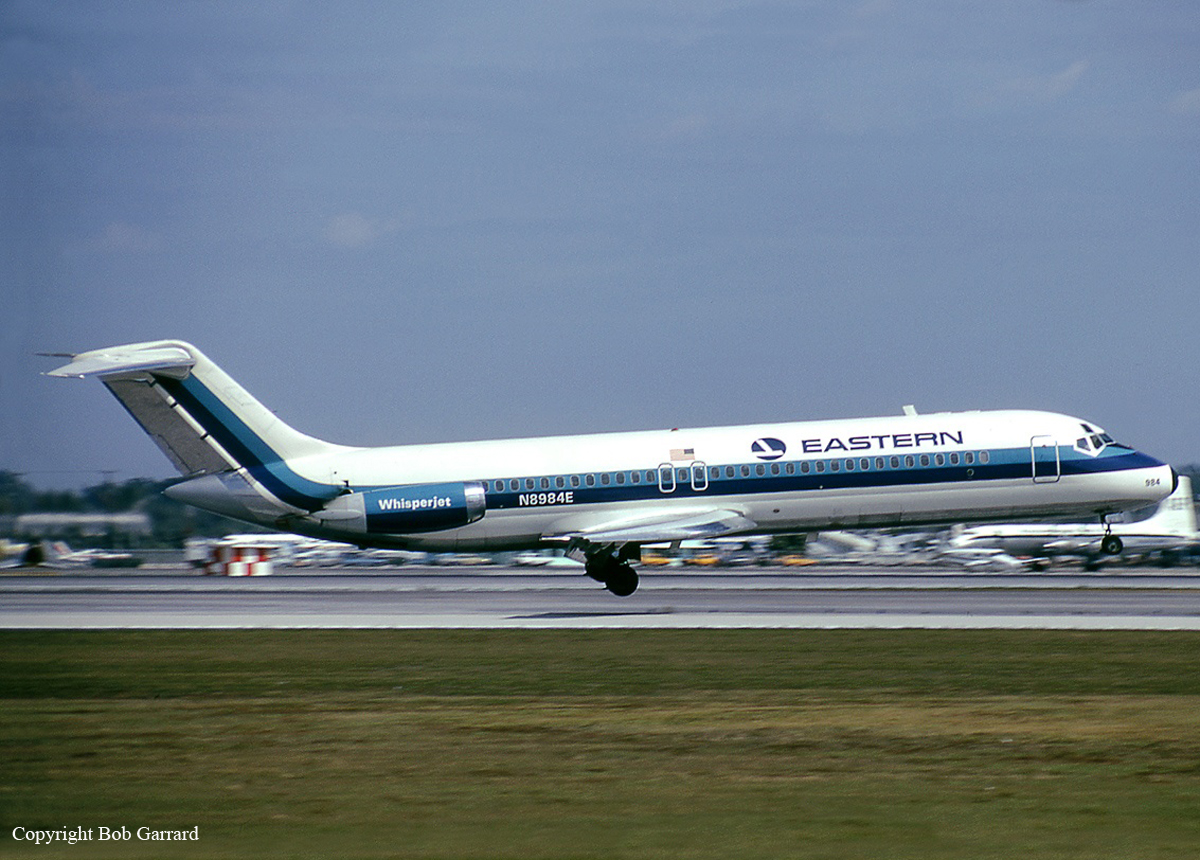

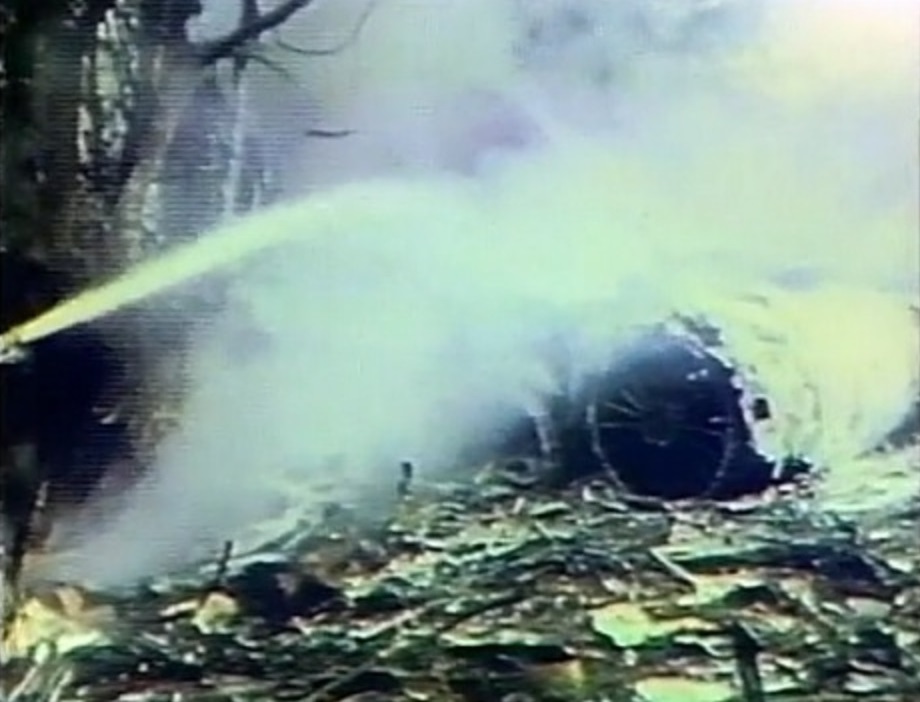

Crash of a Douglas DC-9-31 in Akron
Date & Time:
Nov 27, 1973 at 2129 LT
Registration:
N8967E
Survivors:
Yes
Schedule:
Miami - Pittsburgh - Akron
MSN:
47267/361
YOM:
1968
Flight number:
EA300
Crew on board:
5
Crew fatalities:
Pax on board:
21
Pax fatalities:
Other fatalities:
Total fatalities:
0
Captain / Total hours on type:
736.00
Copilot / Total hours on type:
23
Aircraft flight hours:
15615
Circumstances:
The crew started the approach to Akron-Canton Airport by night and marginal weather conditions. The approach speed was too high and the airplane was also too high and the glide so the crew landed 2,400 feet to far down the runway 01. After touchdown on a wet runway, the airplane was unable to stop within the remaining distance, overran and came to rest. All 26 occupants were evacuated, 15 of them were injured. The aircraft was damaged beyond repair.
Probable cause:
The captain's decision to complete the landing at an excessive airspeed and at a distance too far down a wet runway to permit the safe stopping of the aircraft. Factors which contributed to the accident were:
- Lack of airspeed awareness during the final portion of the approach,
- An erroneous indication of the speed command indicator,
- Hydroplaning.
- Lack of airspeed awareness during the final portion of the approach,
- An erroneous indication of the speed command indicator,
- Hydroplaning.
Final Report:
Crash of a Lockheed L-1011-385 TriStar 1 in the Everglades National Park: 99 killed
Date & Time:
Dec 29, 1972 at 2342 LT
Registration:
N310EA
Survivors:
Yes
Schedule:
New York - Miami
MSN:
N193A-1011
YOM:
1972
Flight number:
EA401
Crew on board:
13
Crew fatalities:
Pax on board:
163
Pax fatalities:
Other fatalities:
Total fatalities:
101
Captain / Total hours on type:
280.00
Copilot / Total hours on type:
306
Aircraft flight hours:
986
Aircraft flight cycles:
502
Circumstances:
The flight from New York-JFK was uneventful and the crew started the descent to Miami-Intl Airport by night and good weather conditions. On approach, the captain instructed 'gear down' but all three green lights failed to illuminate properly. The second officer was instructed to enter the forward electronics bay but the problem could not be resolved. The crew informed ATC about the situation and was cleared to climb to 2,000 feet. The crew then discussed to try to find a solution but failed to realize that the airplane was continuing to descend. When a warning sounded in the cockpit indicating a +/- 250 feet deviation from the selected altitude, none of the crew members react to the warning sound and no action was taken. At 2341LT, the crew was instructed by ATC to turn heading 180 and a minute later, the first officer realized that something was wrong with the altitude. Seven seconds later, while turning in a left angle of 28°, the left engine struck the ground then the aircraft crashed in the Everglades National Park, about 20 miles short of runway threshold, and disintegrated on impact. 77 people were rescued while 99 others were killed, among them five crew members. More than a week later, two survivors died from their injuries.
Probable cause:
Failure of the flight crew to monitor the flight instruments during the final 4 minutes of flight, and to detect an unexpected descent soon enough to prevent impact with the ground. Preoccupation with a malfunction of the nose landing gear position indicating system distracted the crew's attention from the instruments and allowed the descent to go unnoticed. The following findings were reported:
- There was no failure or malfunction of the structure, powerplants, systems, or components of the aircraft before impact, except that both bulbs in the nose landing gear position indicating system were burned out.
- The aircraft struck the ground in a 28' left bank with a high rate of sink.
- There was no fire until the integrity of the left wing fuel tanks was destroyed after the impact.
- The tumor in the cranial cavity of the captain did not contribute to the accident.
- The autopilot was utilized in basic CWS.
- The flight crew was unaware of the low force gradient input required to effect a change in aircraft attitude while in CWS.
- The company training program met the requirements of the Federal Aviation Administration.
- The three flight crewmembers were preoccupied in an attempt to ascertain the position of the nose landing gear.
- The second officer, followed later by the jump seat occupant, went into the forward electronics bay to check the nose gear down position indices.
- The second officer was unable visually to determine the position of the nose gear.
- The flight crew did not hear the aural altitude alert which sounded as the aircraft descended through 1,750 feet msl.
- There were several manual thrust reductions during the final descent.
- The speed control system did not affect the reduction in thrust.
- The flight crew did not monitor the flight instruments during the final descent until seconds before impact.
- The captain failed to assure that a pilot was monitoring the progress of the aircraft at all times
- There was no failure or malfunction of the structure, powerplants, systems, or components of the aircraft before impact, except that both bulbs in the nose landing gear position indicating system were burned out.
- The aircraft struck the ground in a 28' left bank with a high rate of sink.
- There was no fire until the integrity of the left wing fuel tanks was destroyed after the impact.
- The tumor in the cranial cavity of the captain did not contribute to the accident.
- The autopilot was utilized in basic CWS.
- The flight crew was unaware of the low force gradient input required to effect a change in aircraft attitude while in CWS.
- The company training program met the requirements of the Federal Aviation Administration.
- The three flight crewmembers were preoccupied in an attempt to ascertain the position of the nose landing gear.
- The second officer, followed later by the jump seat occupant, went into the forward electronics bay to check the nose gear down position indices.
- The second officer was unable visually to determine the position of the nose gear.
- The flight crew did not hear the aural altitude alert which sounded as the aircraft descended through 1,750 feet msl.
- There were several manual thrust reductions during the final descent.
- The speed control system did not affect the reduction in thrust.
- The flight crew did not monitor the flight instruments during the final descent until seconds before impact.
- The captain failed to assure that a pilot was monitoring the progress of the aircraft at all times
Final Report:
